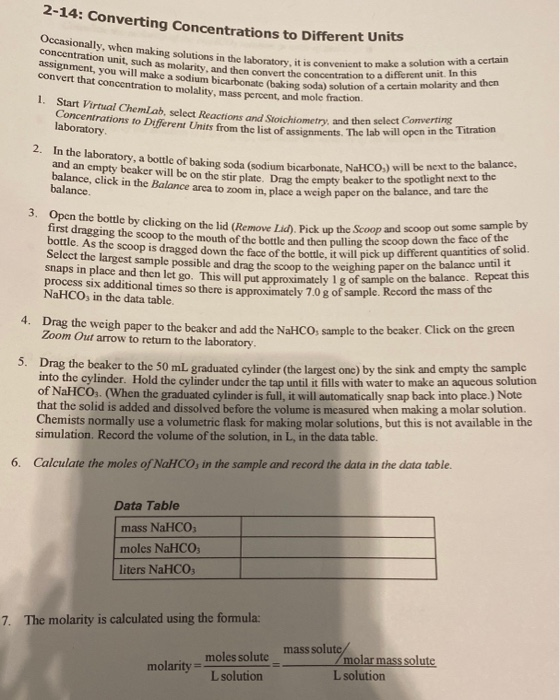Chapter11: Properties Of Solutions
Section: Chapter Questions
Problem 5RQ: Define the terms in Raoults law. Figure 10-9 illustrates the net transfer of water molecules from...
Related questions
Question
attached is a lab. I have all the answers. Can someone just write a nice introduction for this lab for me!! thank you

Transcribed Image Text:2-14: Converting Concentrations to Different Units
concentration unit, such as molarity, and then convert the concentration to a different unit. In this
Occasionally, when making solutions in the laboratory, it is convenient to make a solution with a certain
assignment, you will make a sodium bicarbonate (baking soda) solution of a certain molarity and then
convert that concentration to molality, mass percent, and mole fraction.
1. Start Virtual ChemLab, select Reactions and Stoichiometry, and then select Converting
Concentrations to Different Units from the list of assignments. The lab will open in the Titration
laboratory.
2. In the laboratory, a bottle of baking soda (sodium bicarbonate, NaHCO,) will be next to the balance,
and an empty beaker will be on the stir plate. Drag the empty beaker to the spotlight next to the
balance, click in the Balance area to zoom in, place a weigh paper on the balance, and tare the
balance.
3. Open the bottle by clicking on the lid (Remove Lid). Pick up the Scoop and scoop out some sample by
first dragging the scoop to the mouth of the bottle and then pulling the scoop down the face of the
bottle. As the scoop is dragged down the face of the bottle, it will pick up different quantities of solid.
Select the largest sample possible and drag the scoop to the weighing paper on the balance until it
snaps in place and then let go. This will put approximately 1 g of sample on the balance. Repeat this
process six additional times so there is approximately 7.0 g of sample. Record the mass of the
NaHCO, in the data table.
4.
Drag the weigh paper to the beaker and add the NaHCO, sample to the beaker. Click on the green
Zoom Out arrow to return to the laboratory.
5. Drag the beaker to the 50 mL graduated cylinder (the largest one) by the sink and empty the sample
into the cylinder. Hold the cylinder under the tap until it fills with water to make an aqueous solution
of NaHCO). (When the graduated cylinder is full, it will automatically snap back into place.) Note
that the solid is added and dissolved before the volume is measured when making a molar solution.
Chemists normally use a volumetric flask for making molar solutions, but this is not available in the
simulation. Record the volume of the solution, in L, in the data table.
6. Calculate the moles of NaHCO, in the sample and record the data in the data table.
Data Table
mass NaHCO,
moles NaHCO,
liters NaHCO3
7. The molarity is calculated using the formula:
molarity
moles solute
L solution
=.
mass solute
molar mass solute
L solution
Expert Solution
This question has been solved!
Explore an expertly crafted, step-by-step solution for a thorough understanding of key concepts.
Step by step
Solved in 2 steps

Knowledge Booster
Learn more about
Need a deep-dive on the concept behind this application? Look no further. Learn more about this topic, chemistry and related others by exploring similar questions and additional content below.Recommended textbooks for you


Chemistry
Chemistry
ISBN:
9781305957404
Author:
Steven S. Zumdahl, Susan A. Zumdahl, Donald J. DeCoste
Publisher:
Cengage Learning

Chemistry: An Atoms First Approach
Chemistry
ISBN:
9781305079243
Author:
Steven S. Zumdahl, Susan A. Zumdahl
Publisher:
Cengage Learning


Chemistry
Chemistry
ISBN:
9781305957404
Author:
Steven S. Zumdahl, Susan A. Zumdahl, Donald J. DeCoste
Publisher:
Cengage Learning

Chemistry: An Atoms First Approach
Chemistry
ISBN:
9781305079243
Author:
Steven S. Zumdahl, Susan A. Zumdahl
Publisher:
Cengage Learning

Introduction to General, Organic and Biochemistry
Chemistry
ISBN:
9781285869759
Author:
Frederick A. Bettelheim, William H. Brown, Mary K. Campbell, Shawn O. Farrell, Omar Torres
Publisher:
Cengage Learning

Chemistry & Chemical Reactivity
Chemistry
ISBN:
9781337399074
Author:
John C. Kotz, Paul M. Treichel, John Townsend, David Treichel
Publisher:
Cengage Learning

Chemistry: The Molecular Science
Chemistry
ISBN:
9781285199047
Author:
John W. Moore, Conrad L. Stanitski
Publisher:
Cengage Learning